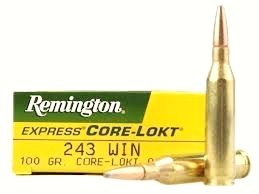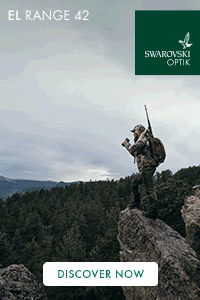Could the .243 Winchester be the Magic Bullet for UK Deer Stalking?
I have to admit loving those old 80’s cop’ films where SWAT teams from the LAPD chase around the back streets of Los Angeles fighting bad guys. Who can forget ‘48hrs’ with Nick Nolte and Eddie Murphy or ‘Lethal Weapon’ with Mel Gibson and Danny Glover playing Riggs and Murtaugh - classic.
Why do I mention my love of these old movies? Well who would have guessed that in real life the calibre of choice for the top marksman on these Special Weapons and Tactic’s teams was the .243 Winchester chambered in a bolt action rifle.
So, what was it that the SWAT teams liked about the .243 and can we learn a thing-or-two about this calibres suitable application from their findings?
 First introduced by Winchester in 1955 as a varmint cartridge the .243 Winchester is, in its simplest terms, a necked down .308 case, which can be loaded with bullet weights that range from 55 grains to 115 grains. Seemingly an unlikely choice for a SWAT team the .243 has none the less always been a highly popular calibre for both vermin and light skinned deer.
First introduced by Winchester in 1955 as a varmint cartridge the .243 Winchester is, in its simplest terms, a necked down .308 case, which can be loaded with bullet weights that range from 55 grains to 115 grains. Seemingly an unlikely choice for a SWAT team the .243 has none the less always been a highly popular calibre for both vermin and light skinned deer.
Here in the UK, the .243 calibre gained an excellent reputation as a modern alternative to the .303. This was reinforced when in 1963 the Deer Act specified at least a .240 calibre for use on deer. However, despite this initial strong start, the .243 Winchester has become somewhat unloved of recent years with many stalkers considering the calibre as old-hat, dated or even underpowered.
Personally, I think they have it wrong and the clue as to why lies in a famous book ‘The Ultimate Sniper’ by John L Plaster. During Plasters lengthy analysis of the benefits of various calibres for urban environments, Plaster refers to the .243 as a “magic bullet” that “solves many of the over penetration concerns”.
Put simply, in the urban environment of downtown L.A the police were understandably concerned about the considerable exit energy of other calibres which might easily result in collateral injury to civilians. Plaster felt that the .243 was the ideal calibre of choice over more powerful calibres which might exacerbate the risk of a bullet travelling a considerable further distance after impact, or directly through backstops which otherwise might impede the progress of the round.
 Of course, I do not wish to compare the rural south east of England with down-town L.A! However, the same considerations are relevant in some of the more densely populated areas of the UK, where Police also have the responsibility to consider the potential for collateral injury to members of the public when deeming certain parcels of land as suitable for a particular calibre. The ability of a round to travel beyond its chosen target is a substantial and reasonable concern in such environments. For this reason, unsurprisingly more parcels of land than any other are deemed suitable for the .243.
Of course, I do not wish to compare the rural south east of England with down-town L.A! However, the same considerations are relevant in some of the more densely populated areas of the UK, where Police also have the responsibility to consider the potential for collateral injury to members of the public when deeming certain parcels of land as suitable for a particular calibre. The ability of a round to travel beyond its chosen target is a substantial and reasonable concern in such environments. For this reason, unsurprisingly more parcels of land than any other are deemed suitable for the .243.
(Left: 'Lethal Weapon' - "I have to admit loving the old 80's cop' films")
The police's inclination to do this is a key reason why I also recommend this calibre to new applicants. The logic being, that by ‘far and away’ the majority of FAC’s have a condition that states words to the effect; “The holder shall be permitted to use the Firearm/ammunition on land deemed suitable by the chief officer of police”, choosing to have a .243 on your ticket therefore, becomes a very sensible choice for anyone expecting this common condition to appear on their licence.
This is one of the fundamental reasons why I continue to recommend the .243 Winchester as a wise choice for any new firearm applicant. By doing so, even if a further slot is subsequently requested for a larger calibre, any new applicant can reasonably expect to be able to access the maximum amount of land available to them without fear of finding that their chosen calibre has not been deemed as suitable on the land on which the holder has permission to shoot. Quite simply, if a plot of land has been deemed suitable for deer stalking, it will almost invariably have been done so for the .243 Winchester.
I hasten to add, that this is not the only reason why I recommend this calibre. It is also because much like the 80’s cop films that I have enjoyed so much, I have a great deal of affection for this flat shooting, very manageable and highly accurate round, that coincidentally was my first ever calibre and one in which I therefore hold a great deal of affection.
Producing around 1950 ft lbs of energy at the muzzle with 100 grain bullet, the .243 goes on to deliver 1600 ft lbs of energy at 100 yards and around 1350 ft lbs of energy at 200 yards. As for the trajectory, whilst being inferior to others such as the .308 parent cartridge, at longer ranges, is in fact flatter shooting than the .308 out to at least 300yards due to its higher velocity. Typical drop for a 100grain bullet with a 100 yard zero is 3.3 inches at 200 yards and 12.5 inches at 300 yards.
And this underlines the point of the calibre, it fades considerably after 300 yards. That’s not to say by any means that I condone using bullet fade as a reasonable excuse for not having a solid backstop, but it does mean that at most ranges in which we encounter deer, the 243 is the flatter calibre, whilst we can have some added reassurance that beyond this it will quickly fade and not retain the substantial unnecessary down range energy of some of its counterparts which require a great deal more stopping.
Perhaps therefore, in highly populated areas of the UK, where back stop and safety are any stalkers primary concerns the .243 might indeed be the ‘magic bullet’.
To read more about Rifle Calibres for deer stalking follow this link: rifle-calibres
Alternatively if you'd like to try out a range of calibres in the field, including the .243, then contact us on: 0203 981 0159 or email:



















